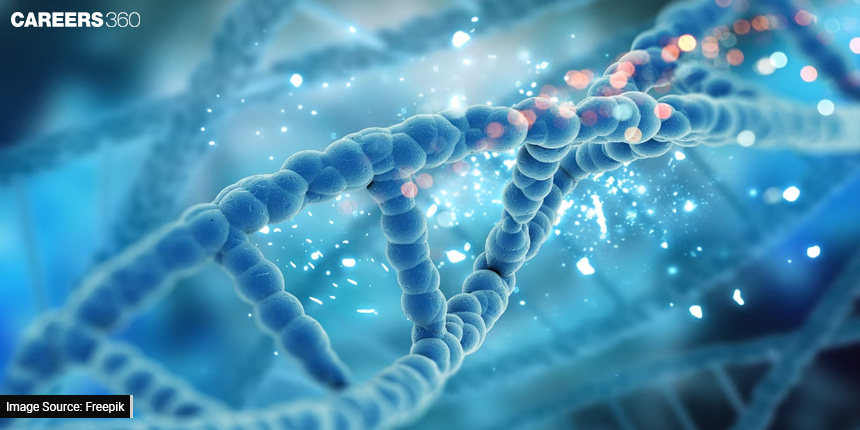DNA Mutations: Causes, Effects, And Disorders
Surely you have heard the word mutation - thanks to the X-Men series. But how aware are you of the scientific effects of mutations on the DNA and the living organism? Well, first of all, let’s dispel the doubt that mutations only impose negative consequences; sometimes, they can be beneficial as well. Mutations are also the cause of many diseases and altered physiology, but they are also the basis of certain traits and evolution.
This Story also Contains
- What Is A Mutation?
- DNA Mutation: Causes and Disorders
- Effects of DNA Mutations
- Estimation of DNA Mutation Rates

Mutations are not only limited to humans, but they can occur in any organism, from bacteria to elephants containing genes.
Also read: Mass Extinction: How Does It Shape Our Ecosystem?
What Is A Mutation?
When there are errors in the DNA sequences due to various internal or external mishaps, it is known as a mutation. Various events like radiation, harmful drugs, long-term exposure to certain drugs, infections, or similar mutagens can cause mutations at the cellular or tissue level.
Moving forward, we need to understand if all types of mutations are inherited or not. Mutations can occur in any part of the cell, which means they can either occur in the somatic cells or the germ cells.
When the alterations are present in the vegetative or somatic cells, then these are termed somatic mutations. Since the information or traits coded by the somatic cells are not inherited, the somatic mutations are not passed on from generation to generation.
Contrary to somatic mutations, genetic mutations occur in the germline or germ cells, due to which the genes or sequences suffer a permanent alteration in the DNA structure. New traits are encoded, and these traits are passed onto the next generation.
DNA Mutation: Causes and Disorders
In both the cases of somatic and genetic mutations, the alterations occur in the DNA sequences or genes. However, only the germ cell DNA is inherited; therefore, genetic mutations are inheritable.
Mutations can occur in various ways, like alteration in one gene, multiple genes, single or multiple chromosomes, and more.
Mutations can occur due to several factors:
Environmental factors like exposure to UV rays or other chemicals can trigger changes in the genetic makeup, due to which structural and functional changes in the genes are produced.
Errors during cell division can produce faulty instructions like addition, duplication, insertion, or substitution of single or multiple genes, thereby altering the genetic makeup and causing impaired cell function.
Some pathogens can attack the DNA and cause alterations, giving rise to genetic mutations.
Some of the genetic disorders are cystic fibrosis, Alzheimer’s and Down syndrome.
Also, read: Cancer Treatment: Why Chemotherapy Does Not Suit All Patients?
Effects of DNA Mutations
Positive Effects
Now, what could be the functions or importance of DNA mutations? Let’s read about them.
Around 3 out of 2000 mutations are beneficial to the organisms. Genetic mutations are one of the main causes of genetic variations, which are crucial for evolution and differences among organisms.
Let's study one interesting example of a mutation in the organism.
Do you know giraffes are not always long-necked creatures? In the population of giraffes, some were able to adapt to reach the leaves and branches of taller trees to survive the food competition. These giraffes gave birth to kids with the benefit of mutation, and therefore long-necked giraffes came into existence.
Negative Effects
The maximum number of mutations that occur in the environment is negative. Harmful mutations can cause mild symptoms like mucus formation, breathing issues, or digestive problems, but severe effects like some types of cancer or other genetic disorders can be caused. Mutation in organisms can affect various aspects like reproduction and survival, protein formation, heart problems, and more.
Hemophilia is another example of a negative mutation in which the gene responsible for the blood clotting factor is mutated, and hence bleeding cannot be stopped.
Cancer is one of the leading causes of death, and some types are caused by mutations. The abnormal growth of cells can occur when errors occur in the genes during cell division, and cell arrest also malfunctions. Due to this, these abnormal cells are not eliminated from the cell cycle and keep on spreading.
Neutral Effects
Sometimes, both harmful and beneficial types of mutations can occur in organisms, which leads to no mutation effects or the production of neutral mutations. Polyploidy is one such example where the flowers of a single plant exhibit two colours, which are neither beneficial nor harmful to the owner.
Estimation of DNA Mutation Rates
It has been observed after experiments and studies that mutations are random. Mutations do not occur as per the requirements or definite outcome, but they occur randomly. Sometimes this statement can be untrue as well because the probability or rates of different mutations vary, which implies that some mutations occur more frequently.
It is necessary to study the mutation rates so as to understand their effects and frequency in the organisms. However, the estimation of mutation rates is extremely tough because the DNA is influenced by multiple factors, and identical DNA has to be studied to understand the mutation differences.
Also, read: How Does Physiology Influence Water Demand In People?
Applications for Admissions are open.
As per latest syllabus. Physics formulas, equations, & laws of class 11 & 12th chapters
JEE Main Important Chemistry formulas
Get nowAs per latest syllabus. Chemistry formulas, equations, & laws of class 11 & 12th chapters
JEE Main high scoring chapters and topics
Get nowAs per latest 2024 syllabus. Study 40% syllabus and score upto 100% marks in JEE
JEE Main Important Mathematics Formulas
Get nowAs per latest syllabus. Maths formulas, equations, & theorems of class 11 & 12th chapters
